Related Research Articles
Telecommunications in the Philippines are well-developed due to the presence of modern infrastructure facilities. The industry was deregulated in 1995 when President Fidel Ramos signed Republic Act No. 7925. This law opened the sector to more private players and improved the provision of telecom services are better and fairer rates, leading to the creation of many telecommunication service providers for mobile, fixed-line, Internet and other services.
The Xavier University – Ateneo de Cagayan, also known simply as the Ateneo de Cagayan or Xavier is a private, Catholic, coeducational, research basic and higher education institution. Xavier is operated by the Philippine Province of the Society of Jesus in Cagayan de Oro, Misamis Oriental, Philippines. Founded in 1933 as the Ateneo de Cagayan, it became the first higher education institution in Mindanao to receive a university status a year before its sister school Ateneo de Manila. It was given its present name in honor of the Jesuit missionary St. Francis Xavier.
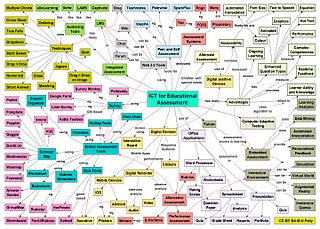
Information and communications technology (ICT) is an extensional term for information technology (IT) that stresses the role of unified communications and the integration of telecommunications and computers, as well as necessary enterprise software, middleware, storage and audiovisual, that enable users to access, store, transmit, understand and manipulate information.

The University of San Carlos is a private, Catholic, research, coeducational basic and higher education institution administered by the Philippine Southern Province of the Society of the Divine Word missionaries in Cebu City, Philippines since 1935. It offers basic education and higher education. Founded originally in 1595 as Colegio de San Ildefonso, it later became the Colegio-Seminario de San Carlos in 1783 and finally obtained university charter in 1948.

Lyceum of the Philippines University also referred to by its acronym LPU is a private, non-sectarian, coeducational higher education institution located at intramuros in the City of Manila, Philippines. It was founded in 1952 by Dr. José P. Laurel, who was the third president of the Republic of the Philippines.

Smart Communications Inc., commonly referred to as Smart, is a wholly owned wireless communications and digital services subsidiary of PLDT Inc., a telecommunications and digital services provider based in the Philippines. As of November 2023, it is currently the largest mobile network with 55.2 million subscribers.

Mapúa University, also known simply as Mapúa or MU, is a private research-oriented non-sectarian university located in Metro Manila, Philippines. The university was founded in 1925 by the first registered Filipino architect, Tomás Mapúa, a graduate of Cornell University in New York, US. In 2000, the university was acquired by the Yuchengco Group of Companies.
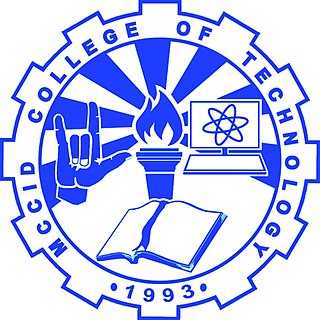
Manila Christian Computer Institute for the Deaf (MCCID) is a non-sectarian, post-secondary, Christian foundation school for the deaf in the Philippines authorized by the Technical Education and Skills Development Authority (TESDA) to offer non-degree computer and other technical training programs.

The College of Computer Studies (CCS) is one of the eight colleges of De La Salle University. It was established in 1981 as the Center for Planning, Information, and Computer Science offering only a Bachelor of Science degree in Computer Science. The department was formally declared as a college in 1984. In 1990, the college was transferred to its new building, the INTELLECT Building, which was eventually renamed as the Gokongwei Building. In 1996 the college was granted semi-autonomous status along with the Graduate School of Business which led to the establishment of De La Salle-Professional Schools, Inc. The college became a part of De La Salle Professional Schools but later transferred back to the university.
The University of the East College of Computer Studies and Systems pioneered in the offering of a baccalaureate degree in Computer Science in the University Belt area starting 1988. Presently the Commission on Higher Education (CHED) has identified the University of the East as a Center of Excellence in Information Technology Education.

Science and technology in the Philippines describes scientific and technological progress made by the Philippines and analyses related policy issues. The main agency responsible for managing science and technology (S&T) is the Department of Science and Technology (DOST). There are also sectoral councils for Forestry, Agriculture and Aquaculture, the Metal Industry, Nuclear Research, Food and Nutrition, Health, Meteorology, Volcanology and Seismology.
The Health Research and Development Information Network PLUS is a research information management system and collaboration platform for Higher Education and Research and Development Institutions to collect, organize, and disseminate research information at the institutional level, making it easier to generate reports for the Commission on Higher Education (CHED), the Department of Science and Technology (DOST), the Department of Health (DOH) and other bodies. It can be accessed at http://herdin.ph.

Internet in the Philippines first became available on March 29, 1994, 10:18 a.m., with the Philippine Network Foundation (PHNet) connecting the country and its people to Sprint in the United States via a 64 kbit/s link. As of February 2023, there are 85.16 million internet users in the country, where internet penetration stood at 73.1% of the total population.
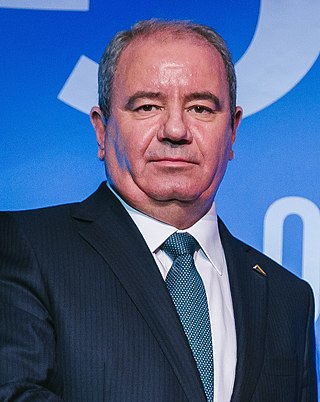
Ali Abbasov Mammad oglu was the Minister of Communications and Information Technologies of the Republic of Azerbaijan between 2004 and 2015.
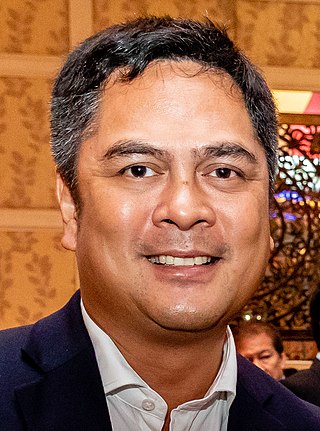
Jose Ruperto Martin Marfori Andanar is a Filipino television news personality, former news anchor, radio commentator, podcaster, voice-over artist and a columnist. He served as the former secretary of the Presidential Communications Office of the Philippines under the Duterte administration and is now CGTN anchor.

The Philippine Overseas Employment Administration was an agency of the Government of the Philippines responsible for opening the benefits of the overseas employment program of the Philippines. It is the main government agency assigned to monitor and supervise overseas recruitment and manning agencies in the Philippines. The POEA's office is located at EDSA corner Ortigas Avenue, Mandaluyong, Philippines.
School of Computing and Information Science Center of the Development for Information Technology (DIT).
Information Communications Technology is usually included in the Home Economics and Livelihood Education program in grade school and taught through the Technology and Home Economics program in high school. The recent status of ICT education in the Philippines, along with other Southeast Asian countries, was surveyed by the Southeast Asian Ministers of Education Organization (SEAMEO) in 2011. Using the UNESCO model of ICT Development in Education, the countries were ranked as Emerging, Applying, Infusing or Transforming. The Philippines were ranked at the Infusing stage of integrating ICT in education, indicating that the country has integrated ICT into existing teaching, learning and administrative practices and policies. This includes components such as a national vision of ICT in education, national ICT plans and policies, complementary national ICT and education policies, professional development for teachers and school leaders, community or partnership and teaching and learning pedagogies. A 2012 study reported that public high schools in Metro Manila had a computer to student ratio of 1:63. While 88 percent of schools have internet connections, half of the students claimed not to be using it.

The digital divide is an economic and social inequality with regard to access to, use of, or impact of information and communication technologies (ICT). Factors causing the divide can vary depending on the country and culture, as can the potential solutions for minimizing or closing the divide.
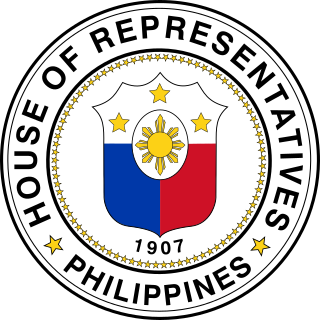
The Philippine House Committee on Information and Communications Technology, or House Information and Communications Technology Committee is a standing committee of the Philippine House of Representatives.
References
- ↑ Norris, P. 2001. Digital divide: Civic engagement, information poverty and the Internet world- wide. Cambridge, MA: Cambridge Univ. Press.
- ↑ "FALLING THROUGH THE NET: A Survey of the "Have Nots" in Rural and Urban America". doc.gov.
- ↑ Patricia, J.P. 2003. 'E-government, E-Asean Task force, UNDP-APDIP'(PDF)
- ↑ Mossberger, K., C.J. Tolbert, and M. Stansbury. 2003. Virtual inequality: Beyond the digital divide. Washington, DC: Georgetown University Press.
- ↑ "What is the digital divide?". 2017-03-22. Retrieved 2017-10-18.
- ↑ Hoeffel, Elizabeth; Rastogi, Sonya; Ouk Kim, Myoung; Shahid, Hasan. "The Asian Population: 2010" (PDF). Census Bureau. Retrieved 5 November 2017.
- ↑ Russell, Jon. "Philippines named Social Networking Capital of the World". Asian Correspondent. Retrieved 5 November 2017.
- ↑ "Millions of Filipinos suffer the social injustice of digital divide: World Bank report". BusinessMirror Philippines. 14 January 2016. Retrieved 2017-10-18.
- ↑ "History of Internet in the Philippines". GOVPH. Retrieved 5 October 2017.
- 1 2 Karan, Kavita; Gimeno, Jacques; Tandoc, Edson. "Internet and Social Networking Sites in Election Campaigns: Gabriela Women's Party in Philippines wins the 2007 Elections" . Retrieved 9 November 2017.
- ↑ Clark, Nick. "Education in the Philippines". World Education News & Reviews. Retrieved 12 October 2017.
- ↑ Cruz, Isagani. "Technology in K to 12". Philippine Star. Retrieved 12 October 2012.
- 1 2 3 4 5 6 7 8 9 10 11 12 13 14 15 16 17 18 19 20 21 22 23 24 25 26 27 28 29 30 31 32 33 34 35 Tiglao, Noriel (2009-07-01). "Mapping ICT4D Projects in the Philippines". Philippine Journal of Public Administration.
- ↑ "Davao City Central 911 Emergency Response Center | The Center for Health Market Innovations". healthmarketinnovations.org. Retrieved 2022-01-27.
- ↑ "A Radio Broadcasting Model for Rural Women and Farm Households". www.fao.org. Retrieved 2022-01-27.
- ↑ "Text2Teach". SEAMEO INNOTECH. Retrieved 2022-01-27.
- ↑ "US-ASEAN Business Council | ed.Venture". US-ASEAN Business Council. Retrieved 2022-01-27.
- ↑ "Mobile Information Technology Classroom Project". www.pda.gov.ph. Retrieved 2022-01-27.
- ↑ "DOH LAUNCHES COVID-19 HOTLINES 1555, 02-894-COVID | Department of Health website". doh.gov.ph. Retrieved 2022-01-27.
- ↑ "How To Register For A Vaccine". Quezon City Government. Retrieved 2022-01-27.
- ↑ "Department of Health website". doh.gov.ph. Retrieved 2022-01-27.
- ↑ "The President's Day: March 21, 2003 | GOVPH". Official Gazette of the Republic of the Philippines. 21 March 2003. Retrieved 2022-01-27.
- ↑ "DTI-Cavite takes part in the BaliKaBayanihan Campaign for OFWs". www.dti.gov.ph. Retrieved 2022-01-27.
- ↑ "Smart powers KSA based-NCB Quick Pay Remittance Service". smart.com.ph. Retrieved 2022-01-27.
- ↑ "IBM and Resources For The Blind, Inc. Hold 13th 'Computer Eyes Camp' For Visually Impaired Students". Orange Magazine. 2014-11-23. Retrieved 2022-01-27.
- ↑ "Philippine eLibrary | National Library of the Philippines". web.nlp.gov.ph. Retrieved 2022-01-27.